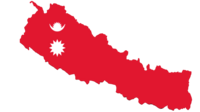Dharanidhar Koirala
Dharanidhar Koirala | |
|---|---|
 | |
| Born | 1893[1] |
| Died | 1980 (aged 86–87)[1] Nepal |
| Nationality | Nepali |
Dharanidhar Koirala (Nepali: धरणीधर कोइराला;1893–1980; also known as Dharanidhar Sharma Koirala) was a Nepali poet sometimes known as Pandit-ji.[2]
Biography[edit]
Dharanidhar Koirala was born in 1893 in what is now Sindhuli District into a Hindu Brahmin family.[3] He studied Sanskrit and English from Banaras, British India.[4] In Banaras, he saw Indian people promoting their mother tongue which inspired him to "think about Nepal and the Nepali language".[4]
In 1918, he was exiled to India, where Koirala, Surya Bikram Gyawali, and Parasmani Pradhan became known as "SuDhaPa".[5] In 1924, Koirala with Surya Bikram Gyawali, Parasmani Pradhan, Hari Prasad Pradhan, and others established the Nepali Sahitya Sammelan in Darjeeling, British India.[6] The establishment of this organisation was seen as a major event in Nepali literature's history.[7]
Koirala was a key advisor to Sir Ralph Lilley Turner who published Comparative and Etymological Dictionary of the Nepali Language in 1931.[2] He wrote poems about social reforms.[8][9] In 1978, Koirala was awarded a Doctor of Letters degree by Tribhuvan University.[10] He was also awarded Tribhuvan Pragya Award by Nepal Academy for his contributions to Nepali literature.[11]
Koirala died in 1980.[4] In 1994, the Government of Nepal issued postage stamps featuring Koirala.[12]
Works[edit]
- Naibedya (1920)[13]
- Jaga Jaga
- Asha
- Spandhana
References[edit]
- ^ a b Onta, p. 2.
- ^ a b Messerschmidt 2014.
- ^ Studies in Nepali History and Society. Mandala Book Point. 1996. p. 50.
- ^ a b c Onta 1996, p. 14.
- ^ "The Darjeeling Luminaries". ECS NEPAL. Retrieved 21 January 2022.
- ^ Datta, Amaresh (1988). Encyclopaedia of Indian Literature: Devraj to Jyoti. Sahitya Akademi. p. 1382. ISBN 978-81-260-1194-0.
- ^ Chettri, Bhanu (2006). Jagat Chettri. Sahitya Akademi. p. 54. ISBN 978-81-260-2287-8.
- ^ "Movements For Autonomy in Darjeeling". The University of Chicago. Retrieved 21 April 2021.
- ^ The Journal of the Anthropological Survey of India. The Survey. 2002. p. 126.
- ^ Parmanand (1982). The Nepali Congress Since Its Inception: A Critical Assessment. B.R. Publishing Corporation. p. 5.
- ^ "Pragya Award". Nepal Academy. 9 May 2017. Retrieved 21 January 2022.
- ^ "Stamp: Famous People- Dharanidhar Koirala (Nepal) (Famous people)". Colnect. Retrieved 21 January 2022.
- ^ Subba, J. R. (2008). History, Culture and Customs of Sikkim. Gyan Publishing House. p. 169. ISBN 978-81-212-0964-9.
Citations[edit]
- Onta, Pratyoush. "Activities in A 'fossil State': Balkrishna Sama and The Improvisation Of Nepali Identity" (PDF). Martin Chautari. Retrieved 21 April 2021.<
- Messerschmidt, Don (January 2014). "The Darjeeling Luminaries". ECS Nepal. Retrieved 21 April 2021.
- Onta, Pratyoush (June 1996). "Creating a Brave Nepali Nation in British India" (PDF). Martin Chautari. Retrieved 21 April 2021.


 French
French Deutsch
Deutsch